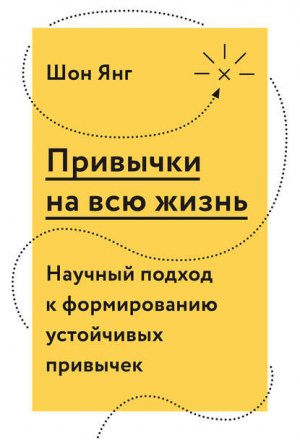Привычки на всю жизнь. Научный подход к формированию устойчивых привычек Янг Шон

‹‹46›› Meredith Derby Berg, Turnaround Tales from JC Penney, Best Buy, AdvertisingAge, February 24, 2014, http://adage.com/article/cmo-strategy/turnaround-tales-jc-penney-buy/291813/.
‹‹47›› Fida Chaaban, Social Entrepreneurship Is on the Rise: Soushiant Zanganehpour’s Advice for ‘Treps Acting as Agents of Change’, Entrepreneur Middle East, October 22, 2015, https://www.entrepreneur.com/article/251981.
‹‹48›› Blake Mycoskie, The Founder of TOMS on Reimagining the Company’s Mission, Harvard Business Review, 2016, https://hbr.org/2016/01/the-founder-of-toms-on-reimagining-the-companys-mission.
‹‹49›› Jeff Chu, Toms Sets Out To Sell A Lifestyle, Not Just Shoes, Fast Company, June 17, 2013, https://www.fastcompany.com/3012568/blake-mycoskie-toms.
‹‹50›› Laura L. Carstensen, The Influence of a Sense of Time on Human Development, Science 312, no. 5782 (2006): 1913–15, doi:10.1126/science.1127488.
Глава 8. Привычка
‹‹1›› Anna Rose Childress, Ronald N. Ehrman, Ze Wang, Yin Li, Nathan Sciortino, Jonathan Hakun, William Jens, et al, Prelude to Passion: Limbic Activation By ‘unseen’ drug and Sexual Cues, PloS One 3, no. 1 (2008): e1506, doi:10.1371/journal.pone.0001506.
‹‹2›› Kimberly A. Young, Teresa R. Franklin, David C. S. Roberts, Kanchana Jagannathan, Jesse J. Suh, Reagan R. Wetherill, Ze Wang, Kyle M. Kampman, Charles P. O’Brien, and Anna Rose Childress, Nipping Cue Reactivity in the Bud: Baclofen Prevents Limbic Activation Elicited by Subliminal Drug Cues, Journal of Neuroscience 34, no. 14 (2014): 5038–43, doi:10.1523/JNEUROSCI.4977-13.2014.
‹‹3›› Gabrielle Giffords, https://en.wikipedia.org/wiki/Gabrielle_Giffords.
‹‹4›› Todd Ackerman, Meet Therapy Team Helping Giffords, Houston Chronicle, November 20, 2011, http://www.chron.com/news/houston-texas/article/Meet-therapy-team-helping-Giffords-2279624.php.
‹‹5›› Bogdan Draganski, Christian Gaser, Volker Busch, Gerhard Schuierer, Ulrich Bogdahn, and Arne May, Neuroplasticity: Changes in Grey Matter Induced by Training, Nature 427, no. 6972 (2004): 311–12, doi:10.1038/427311a.
‹‹6›› Antonella Gasbarri, Assunta Pompili, Mark G. Packard, and Carlos Tomaz, Habit Learning and Memory in Mammals: Behavioral and Neural Characteristics, Neurobiology of Learning and Memory 114 (October 2014): 198–208, doi:10.1016/j.nlm.2014.06.010.
‹‹7›› R. B. Zajonc, Feeling and Thinking: Preferences Need No Inferences, American Psychologist 35, no. 2 (1980): 151–175.
‹‹8›› Henry H. Yin and Barbara J. Knowlton, The Role of the Basal Ganglia in Habit Formation, Nature Reviews Neuroscience 7, no. 6 (2006): 464–476, doi:10.1038/nrn1919.
‹‹9›› G. F. Koob and M. Le Moal, Drug Abuse: Hedonic Homeostatic Dysregulation, Science (New York, NY.) 278, no. 5335 (1997): 52–58.
‹‹10›› G. F. Koob and M. Le Moal, Drug Addiction, Dysregulation of Reward, and Allostasis, Neuropsychopharmacology 24, no. 2 (2001): 97–129, doi:10.1016/S0893-133X(00)00195-0.
‹‹11›› George F. Koob, Alcoholism: Allostasis and Beyond. Alcoholism, Clinical and Experimental Research 27, no. 2 (2003): 232–243, doi:10.1097/01.ALC.0000057122.36127.C2.
‹‹12›› George F. Koob, Alcoholism: Allostasis and Beyond. Alcoholism, Clinical and Experimental Research 27, no. 2 (2003): 232–243, doi:10.1097/01.ALC.0000057122.36127.C2, Zajonc, p. 160.
‹‹13›› A. J. DeCasper and W. P. Fifer, Of Human Bonding: Newborns Prefer Their Mothers’ Voices, Science 208, no. 4448 (1980): 117476, doi:10.1126/science.7375928.
‹‹14›› R. B. Zajonc, Mere Exposure: A Gateway to the Subliminal, Current Directions in Psychological Science 10, no. 10 (2000): 224–28.
‹‹15›› Jennifer L. Monahan, Sheila T. Murphy, and R. B. Zajonc, Subliminal Mere Exposure: Specific, General, and Diffuse Effects, Psychological Science 11, no. 6 (2000): 462–66, doi:10.1111/1467-9280.00289.
‹‹16›› David J. Kelly, Paul C. Quinn, Alan M. Slater, Kang Lee, Alan Gibson, Michael Smith, Liezhong Ge, and Olivier Pascalis, Three-Month-Olds, but Not Newborns, Prefer Own-Race Faces, Developmental Science 8, no. 6 (2005): F31–36, doi:10.1111/j.1467–7687.2005.0434a.x.
‹‹17›› Leslie A. Zebrowitz, Benjamin White, and Kristin Wieneke, Mere Exposure and Racial Prejudice: Exposure to Other-Race Faces Increases Liking for Strangers of That Race, Social Cognition 26, no. 3 (2008): 259–75, doi:10.1521/soco.2008.26.3.259.
‹‹18›› Lara Salahi, «Meditation Heals Military Vets with PTSD,» ABC News, June 6, 2011, http://abcnews.go.com/Health/Depression/meditation-heals-military-vets-ptsd/story?id=13756395.
‹‹19›› Michael Christopher, A Broader View of Trauma: A Biopsychosocial-Evolutionary View of the Role of the Traumatic Stress Response in the Emergence of Pathology And/Or Growth, Clinical Psychology Review 24, no. 1 (2004): 75–98, doi:10.1016/j.cpr.2003.12.003.
‹‹20›› Emily A. Holmes, Ella L. James, Thomas Coode-Bate, and Catherine Deeprose, Can Playing the Computer Game ‘Tetris’ Reduce the Build-Up of Flashbacks for Trauma? A Proposal from Cognitive Science, PLOS ONE 4, no. 1 (2009): e4153, doi:10.1371/journal.pone.0004153.
‹‹21›› Sara W. Lazar, Catherine E. Kerr, Rachel H. Wasserman, Jeremy R. Gray, Douglas N. Greve, Michael T. Treadway, Metta McGarvey, et al, Meditation Experience Is Associated with Increased Cortical Thickness. Neuroreport 16, no. 17 (2005): 1893–97.
‹‹22›› Richard J. Davidson, Jon Kabat-Zinn, Jessica Schumacher, Melissa Rosenkranz, Daniel Muller, Saki F. Santorelli, Ferris Urbanowski, Anne Harrington, Katherine Bonus, and John F. Sheridan, Alterations in Brain and Immune Function Produced by Mindfulness Meditation, Psychosomatic Medicine 65, no. 4 (2003): 564–70, doi:10.1097/01.PSY.0000077505.67574.E3.
‹‹23›› Emma M. Seppala, 20 Scientific Reasons to Start Meditating Today, Psychology Today, September 11, 2013, https://www.psychologytoday.com/blog/feeling-it/201309/20-scientific-reasons-start-meditating-today.
‹‹24›› Eileen Luders, Arthur W. Toga, Natasha Lepore, and Christian Gaser, The Underlying Anatomical Correlates of Long-Term Meditation: Larger Hippocampal and Frontal Volumes of Gray Matter, NeuroImage 45, no. 3 (2009): 672–78, doi:10.1016/j.neuroi.2008.12.061.
‹‹25›› Сообщение в сообществе HOPE от 25 июля 2016 года.
‹‹26›› Eric Vilas-Boas, What the Hell is Michael Phelps’ Arm-Swinging Warmup About? Thrillist, August 10, 2016, https://www.thrillist.com/news/nation/rio-olympics-2016-michael-phelps-arm-stretch-swimming.
‹‹27›› What the Greatest Olympic Athlete Ever Can Teach You about Becoming a Champion, Competitive Advantage, https://www.competitivedge.com/what-greatest-olympic-athlete-ever-can-teach-you-about-becomin-gchampion.
‹‹28›› Joseph D. Lyons, Michael Phelps’ Pre-Race Playlist Is Highly Sought After for a Very Good Reason. Bustle, August 8, 2016, http://www.bustle.com/articles/177333-michael-phelps-pre-race-playlist-is-highlysought-after-for-a-very-good-reason.
Глава 9. Соберем всё вместе
‹‹1›› Личная беседа с Чарли Браке, 2 февраля 2017 года.
‹‹2›› Sarah Klein, I Went To Rehab For My Technology Addiction. Prevention, October 19, 2016, http://www.prevention.com/mind-body/i-went-to-rehab-for-my-technology-addiction.
‹‹3›› Yu-Kang Lee, Chun-Tuan Chang, You Lin, and Zhao-Hong Cheng, The Dark Side of Smartphone Usage: Psychological Traits, Compulsive Behavior and Technostress, Computers in Human Behavior 31 (February 2014): 373–83, doi:10.1016/j.chb.2013.10.047.
‹‹4›› Richard Emanuel, Rodney Bell, Cedric Cotton, Jamon Craig, Danielle Drummond, Samuel Gibson, Ashley Harris, et al, The Truth About Smartphone Addiction, College Student Journal 49, no. 2 (2015): 291–99.
‹‹5›› Sean D. Young, Explaining Pokemon Go through the ‘Science of Social’, July 22, 2016, http://seanyoungphd.com/blog/2016/7/22/explaining-pokmon-go-through-the-science-of-social.
‹‹6›› Jenny S. Radesky, Jayna Schumacher, and Barry Zuckerman, Mobile and Interactive Media Use by Young Children: The Good, the Bad, and the Unknown, Pediatrics 135, no. 1 (2015): 1–3, doi:10.1542/peds.2014–2251.
‹‹7›› Nick Bilton, Steve Jobs Was a Low-Tech Parent, The New York Times, September 10, 2014, http://www.nytimes.com/2014/09/11/fashion/steve-jobs-apple-was-a-low-tech-parent.html?_r=0.
‹‹8›› Личная беседа с сержантом Моррисоном, 8 января 2017 года.
‹‹9›› Operant conditioning, https://en.wikipedia.org/wiki/Operant_conditioning.
‹‹10›› Henry L. Roediger III., What Happened to Behaviorism, Association for Psychological Science, 2004, http://www.psychologicalscience.org/observer/what-happened-to-behaviorism#.WG1ue33JLaU.
‹‹11›› Henry L. Roediger III., What Happened to Behaviorism, Association for Psychological Science, 2004, http://www.psychologicalscience.org/observer/what-happened-to-behaviorism#.WG1ue33JLaU, Klein.
‹‹12›› Recruit training, https://en.wikipedia.org/wiki/Recruit_training.
‹‹13›› Christina Salmivalli and Elisa Poskiparta, Making Bullying Prevention a Priority in Finnish Schools: The KiVa Antibullying Program, New Directions for Youth Development 133 (2012): 41–53, doi:10.1002/yd.20006.
‹‹14›› Anne L. Williford, Christian Elledge, Aaron J. Boulton, Kathryn J. DePaolis, Todd D. Little, and Christina Salmivalli, Effects of the KiVa Antibullying Program on Cyberbullying and Cybervictimization Frequency Among Finnish Youth, Journal of Clinical Child & Adolescent Psychology 42, no. 6 (2013): 820–33, doi:10.1080/15374416.2013.787623.
Максимально полезные книги
Если у вас есть замечания и комментарии к содержанию, переводу, редактуре и корректуре, то просим написать на [email protected], вы поможете нам исправить недочеты и стать лучше.
Заходите в гости:
Для корпоративных клиентов:
Эту книгу хорошо дополняют
М. Дж. Райан
Маршалл Голдсмит, Марк Рейтер
Келли Макгонигал
М. Дж. Райан
Оуэйн Сервис, Рори Галлахер
Над книгой работали
Главный редактор Артем Степанов
Ответственный редактор Светлана Мотылькова
Литературный редактор Анна Кудрявская-Панина
Арт-директор Алексей Богомолов
Дизайн обложки Александр Московский
Верстка Вячеслав Лукьяненко
Корректоры Вера Вересиянова, Мария Кантурова
ООО «Манн, Иванов и Фербер»
Электронная версия книги подготовлена компанией Webkniga.ru, 2018






